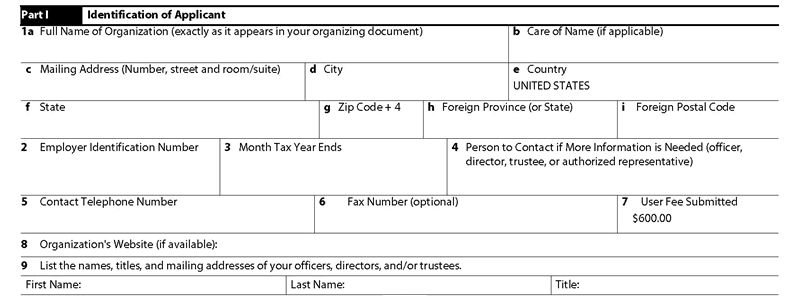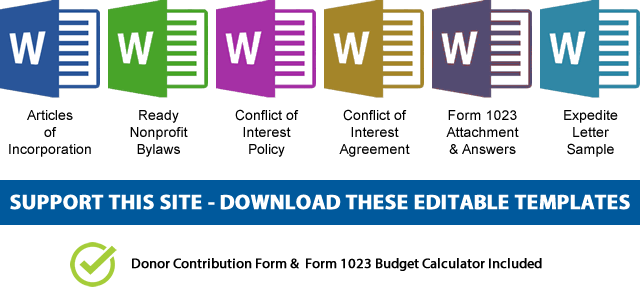The new Form 1023 online version on Pay.gov
Form 1023 is now filed exclusively through Pay.gov — the IRS no longer accepts paper applications. The Pay.gov version doesn’t have traditional page numbers, but all the part numbers and question numbers are the same. Every instruction on this site matches the current online version. If something doesn’t line up or you find a broken link, let me know.
You can still download a printable PDF copy of Form 1023 here, but use it only as a reference; the official form must be completed online at pay.gov.
When you fill out the form 1023 online on pay.gov, it won’t be submitted until you pay. You can save your progress and come back to edit it anytime. After saving, you’ll find your form under “My Saved Forms” – just click the PDF icon to download it. If you want me to review your application, please send that PDF version not a handwritten copy.
In Part I of Form 1023, the IRS asks basic questions to establish who you are and whether you legally exist as a nonprofit. This is where your tax-exempt journey officially begins.

Form 1023 Part I, Full name of organization (exactly as it appears in your organizing document)
This should be obvious, but it trips people up all the time. Use the exact name from your organizing document — word for word. If your articles say “Bread For Dummies Corp.”, don’t write “Bread For Dummies Corporation.” This name must match everywhere — on your EIN, your bylaws, your bank account, and every part of your Form 1023. Get it wrong, and you’ll confuse the IRS and delay your approval.
Form 1023 Part I, c/o Name (if applicable)
List your main point of contact here — usually your president or whoever’s handling the Form 1023. All IRS communication will go to this person.
Don’t list your entire board. Pick one responsible adult so you’re not chasing five people trying to figure out who got the IRS letter.
Form 1023 Part I, Mailing address (Number and street)
Use a P.O. Box if you can. It’s reliable, secure, and your dog won’t eat your IRS determination letter.
If you already have an office with consistent mail delivery, fine, use that. But if you’re working from home or things are still in flux, get a dedicated mailbox. The IRS needs a stable, permanent address to send important stuff. Don’t risk it.
Form 1023 Part I, Employer Identification Number (EIN)
You should already have your EIN, see What is an EIN and how to get one for your 501c3 nonprofit if you don’t.
Form 1023 Part I, Month the annual accounting period ends
It’s entirely up to your board to set your fiscal year. It can be January, March, or any other month. It’s a good idea to set your fiscal year to December 31st so every accounting period ends with the actual year.
Some organizations such as schools set their fiscal tax year to June because that’s when schools generally close for the year. But if you’re not a school, you should always use December and save yourself an accounting headache.
Form 1023 Part I, Person to Contact if More Information is Needed (officer, director, trustee, or authorized representative)
Use the officer or director you listed in the section b on this page. Keep that person the same throughout the application including the signature line.
Form 1023 Part I, Organization’s website:
If you are starting a nonprofit organization out of your home or actually care about succeeding with your mission, you need a website. There’s no way around it. Not later. Not tomorrow. Now. You need to have it up and running before you submit your application. Your organization’s website is your image for the IRS, where they can find more information and see if you actually mean business. In short, your website is your real office.
You can run an organization out of your garage with a well built website, but you can’t reach potential audience and donors without it. Think of it this way; how many of you have ever been to Google’s headquarters, and how many of you have been to Google’s website? Your nonprofit website also serves as a medium for transparency by publicly sharing your organizational documents which are required by law. Please see Tax Exempt Organizations Public Disclosure Requirements to see what documents you have to make available for public inspection.
Not only that, the IRS explicitly instructs its examiners of your application to review the exempt organization’s website for existence of required disclosure for tax deductibility on your donation page.
If you don’t have a website yet, you can get 75% off nonprofit website design through DreamDare Production.
Form 1023 Part I, List the names, titles, and mailing addresses of your officers, directors, and/or trustees.
Here you should list the name of all your directors and their corresponding contact information. If you need to add more directors, I suggest using my downloadable attachment rather than using the box provided.
There is no minimum number for directors in a nonprofit organization set by the Federal Government (minimums are usually set by state law), but the IRS wants to see that the organization is managed by a qualified and diverse board of directors. A good nonprofit board of directors should at least have four or five directors and preferably from both sexes. If you have two directors that are on the board who are related to each other, you need to count them as only one (1), and up the number of directors to 5 or 6.
The more engaged and qualified your board is, the better the outcome of your nonprofit organization will be. Distribution of power is what the IRS has in mind, and a two or three-member board of directors doesn’t guarantee that. Directors of a nonprofit organization CANNOT be compensated for their board duties.
(Next Step) Instructions For Form 1023 Part II – Organizational Structure
(Previous Step) What Is An EIN And How To Get One For Your Nonprofit
 NOTE: If you’d like to receive the following organizing documents:
NOTE: If you’d like to receive the following organizing documents:- Nonprofit Articles of Incorporation,
- Nonprofit Bylaws,
- Nonprofit Conflict of Interest Policy,
- Conflict of Interest Policy Acknowledgment,
- Form 1023 Attachment with all the answers,
- Form 1023 Expedite Letter template,
- and Donor Contribution Form
in Microsoft Word Document format, please consider making a donation and you’ll get to download them immediately. Not only they're worth well over $1000 in value, they will save you weeks of copy pasting and formatting as they are ready to go templates which only need changing names and addresses.

